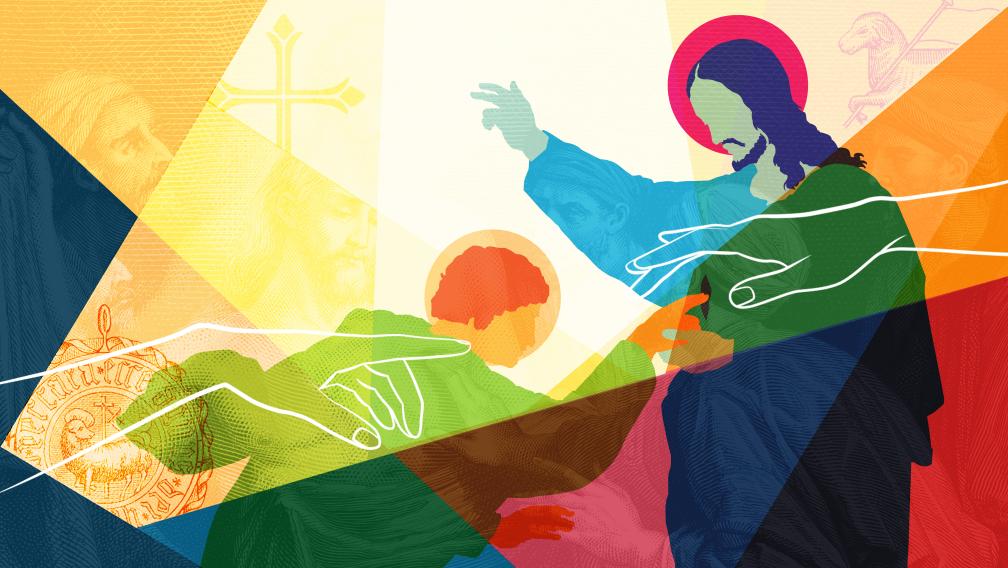“But Thomas . . . one of the twelve [disciples of Jesus], was not with them when Jesus came. So, the other disciples told him, ‘We have seen the Lord.’ But he said to them, ‘Unless I see the mark of the nails in his hands and put my finger in the mark of the nails and my hand in his side, I will not believe.’” — John 20:24–25
A Look Ahead to Sunday’s Readings
In the whirlwind of our daily worries, and especially in times of profound suffering, it can be hard to sense that God is present to us. The tumult of news blaring from our smartphones — the reality of larger forces we cannot control — merge with our ordinary but important concerns: How will I pay my bills? When will I stop grieving? How can I care for my family, friends, and neighbors? When we’re stuck in our uncertainties, God can feel like an abstract concept that has nothing to do with our everyday lives. From the middle of a storm, it’s easy to doubt God is paying attention at all.
In this Sunday’s scripture, the Gospel of John relays an interesting anecdote that speaks to this conundrum. Thomas, one of Jesus’s close disciples, hears an astounding rumor: Jesus, who only a week before was crucified by the power of Rome, has risen from the dead.
Thomas is incredulous. Though he has witnessed many miracles — Jesus turning water into wine, healing a blind man, and raising their friend Lazarus from the dead — the idea that Jesus has been permanently resurrected is too much. Thomas has to see it to believe it. “Unless I see the mark of the nails in his hands and put my finger in the mark of the nails and my hand in his side,” he says, “I will not believe.”
Thomas’s hope is granted. A week later at a gathering of the disciples, Jesus suddenly appears. Thomas is astounded. He is able to touch the gruesome wounds in Jesus’s hands. He is able to talk with Jesus, eat a meal with him, and commune with him once more.
It’s important to note Jesus does not condemn Thomas’s doubts. Rather, he tenderly shows up for Thomas in the way Thomas needs. He affirms sometimes we just can’t get by without tangible evidence. But Jesus also offers a gift to his disciples, and to us, noting: “Blessed are those who have not seen and yet have come to believe.”
It is through the love the disciples have for one another that God’s presence will now be known
Here, Jesus affirms a great mystery. The physical proof God is “there” is not necessary for belief — neither in Jesus’s time nor our own. All those who come after the disciples, including us, might not have the privilege of seeing Jesus face to face. But this does not disqualify us from having a relationship with the risen Christ, the one who is indeed God in human form.
Rather, it is through the love the disciples have for one another that God’s presence will now be known. As the disciples pass down the message of what God has done in Jesus, their mission eventually becomes our mission. We are the hands and feet of Christ in the world, sent out to care for all who suffer and pray. We do this work with our own wounds intact, moving in tender trust with God’s spirit.
If God does not condemn Thomas’s doubts, God does not condemn ours. God merely says, “I am here.” God is in every act of kindness we offer, in each moment we listen compassionately to the worries and concerns of others. God is listening to us, too, hearing our prayers and petitions, even when the evidence is lacking, or we do not receive exactly what we asked for. Trusting in God means both placing our confidence in a larger plan and knowing God does indeed care about each of us. God cares enough, in fact, to come and live among us — and God is with us still.
Read all of Sunday’s scriptures.
Here are five ways to meditate on God’s abiding presence alongside our doubt:
Art In his incredible work “The Incredulity of Saint Thomas,” Baroque painter Caravaggio explores the tenderness of Jesus’s response to his disciple. Since Caravaggio experienced great spiritual doubts in his own life, this painting is all the more profound.
Theology Blogger Joseph Richardson, of The Lonely Pilgrim, thinks about Thomas as more than an intellectual doubter: “The sense I get of Thomas, overall, is not the hard-nosed skeptic, but the passionate, devoted follower, deeply feeling . . . His doubt was deeply rooted in disappointment and loss. How could he bring himself to believe again?
Music Choreographer Rebekah Hampton Barger, founder of Nashville-based contemporary dance company FALL, reinterprets the message of “Doubting Thomas” through movement.
World Christianity Though he is known for his doubt, St. Thomas was so convinced of his experience with Jesus that he traveled the world to share the gospel news and founded the ancient Mar Thoma Church.
Poetry In a profound meditation on everyday doubt, poet Jane Hirshfield writes:
I would like
to grow content in you, doubt,
as a double-hung window
settles obedient into its hidden pulleys and ropes.
I doubt I can do so:
your own counterweight governs my nights and my days.
Subscribe for Trinity Updates
Get information about Trinity Church Wall Street and our latest programming.
